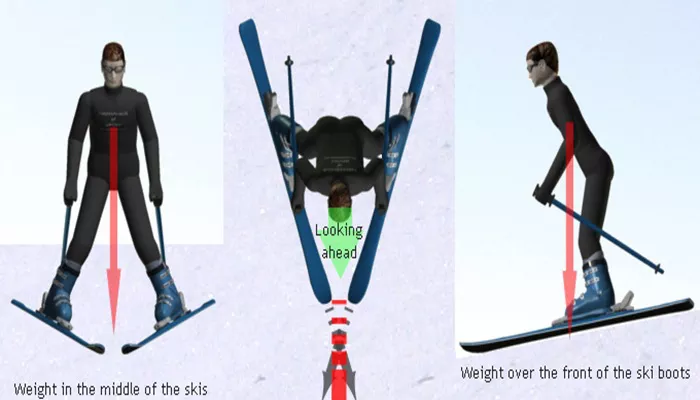Leaning back while skiing is a common problem for beginners and even some intermediate skiers. This habit not only reduces control and efficiency on the slopes but can also increase the risk of injury. Skiing is a sport that demands precise body alignment and dynamic balance. When your weight shifts too far back, your skis lose edge grip, your quads fatigue quickly, and your ability to turn sharply or control speed diminishes.
To ski effectively, mastering forward stance is essential. This article breaks down the mechanics of body positioning, explains why leaning back happens, and provides proven strategies to correct it. From technical advice to muscle memory training, each section delivers practical steps to help you adopt and maintain a forward-leaning, centered skiing posture.
Understanding the Problem
Many skiers lean back because of fear, poor stance, or equipment issues. It feels safer to retreat from the slope, especially on steeper terrain. But this instinct causes imbalance. When your hips are behind your heels, your skis accelerate without guidance, making it harder to stop or turn. The key is to keep your center of mass over your feet and aligned with your ski boots.
Biomechanics of Skiing Posture
In proper stance, your ankles flex, knees bend slightly, and your hips align over your boots. Your chest stays upright, and your hands remain in front. The spine should stay neutral—not hunched or overly arched. Keeping this balance demands core engagement, ankle mobility, and confident edge use.
Why Leaning Back Happens
Several factors contribute:
Fear: Especially on steep slopes or icy runs, skiers retreat backwards.
Fatigue: Tired legs lead to poor posture.
Incorrect Boot Fit: Boots that are too stiff or poorly adjusted hinder ankle flexion.
Lack of Confidence: Skiers who aren’t sure of technique revert to a defensive stance.
How to Recognize If You’re Leaning Back
Pay attention to these signs:
Quads burn quickly, even on easy runs.
Ski tips rise off the snow or chatter excessively.
You feel out of control or slide backward.
Falls often result in landing on your backside.
Use video analysis or have an instructor observe you to confirm your posture.
How to Stop Leaning Back When Skiing?
1. Center Your Weight
Focus on aligning your hips over your feet. Imagine a vertical line dropping from your nose to your toes. Slightly bend your ankles and press your shins into the front of your boots. Avoid over-flexing the knees or sticking your backside out.
2. Engage the Core
Strong core muscles support upright posture. Tighten your abdominal muscles slightly while skiing. This doesn’t mean stiffening up—it’s about maintaining a balanced, dynamic position that can respond to terrain changes.
3. Hands Forward
Keeping your hands in front helps bring your torso forward. Picture holding a tray at chest level. Dropping your hands allows your shoulders and chest to lean back. Use pole plants strategically to guide motion and support rhythm.
4. Flex the Ankles
The ankle joint is your primary steering axis. If the ankles stay locked, other parts of the body overcompensate. To practice ankle flexion:
Stand in your boots on flat ground and shift your weight forward until your shins touch the tongue of your boots.
Try hopping gently in place to test flexibility and balance.
5. Look Ahead
Gazing down at your skis tilts your upper body back. Instead, focus your eyes 10–15 meters down the slope. This encourages a more forward-leaning posture and helps anticipate terrain changes.
6. Use Drills to Reinforce Forward Posture
Consistent practice builds muscle memory. Try these drills:
Javelin Turn: Lift the inside ski while turning to force forward weight distribution.
One-Ski Skiing: Forces balance over the foot and discourages leaning back.
Hands-on-Knees: Lightly tap your knees to ensure your hands stay forward.
Boot Touch: Reach forward to tap your boot tops while skiing gently.
Choosing the Right Equipment
1. Boot Fit Matters
Improperly fitted boots inhibit movement. Ensure boots:
Match your foot size and shape.
Provide forward flex, not excessive stiffness.
Have snug heel pockets and adequate ankle support.
Visit a bootfitter to check alignment and canting adjustments.
2. Ski Design and Length
Long skis or overly stiff skis are harder to maneuver for beginners. Use skis that match your skill level and body weight. Modern all-mountain skis with moderate flex help initiate turns and maintain balance.
Mental Approaches to Improve Stance
1. Visualization
Before each run, close your eyes and visualize a centered, aggressive stance. Picture your knees and shins driving forward.
Repeating mental images helps reinforce correct habits.
2. Confidence Through Repetition
Familiarity reduces fear. Practice easy slopes with purpose. Focus not on speed, but on balance. Avoid icy or overly steep terrain during training phases.
3. Slow Down
Control precedes speed. Skiing too fast, too early leads to defensive posture. Ski at a pace that allows thought and adjustment.
Strength and Mobility Training
1. Ankle and Calf Mobility
Limited ankle range leads to leaning back. Stretch calves and perform ankle mobility drills like wall lunges, dorsiflexion stretches, and balance board exercises.
2. Core Strength
Add planks, bird dogs, and rotational exercises to your workouts. A strong core allows upright skiing and better directional control.
3. Quadriceps and Glutes
Target squats, lunges, and step-ups. Strong legs support forward stance and absorb terrain impact.
Conclusion
Leaning back while skiing is a fixable habit. With the right mindset, body awareness, and consistent practice, you can adopt a balanced, forward-leaning stance. Centering your weight, flexing your ankles, engaging your core, and trusting your gear will make you not only a more skilled skier but a safer and more confident one.

